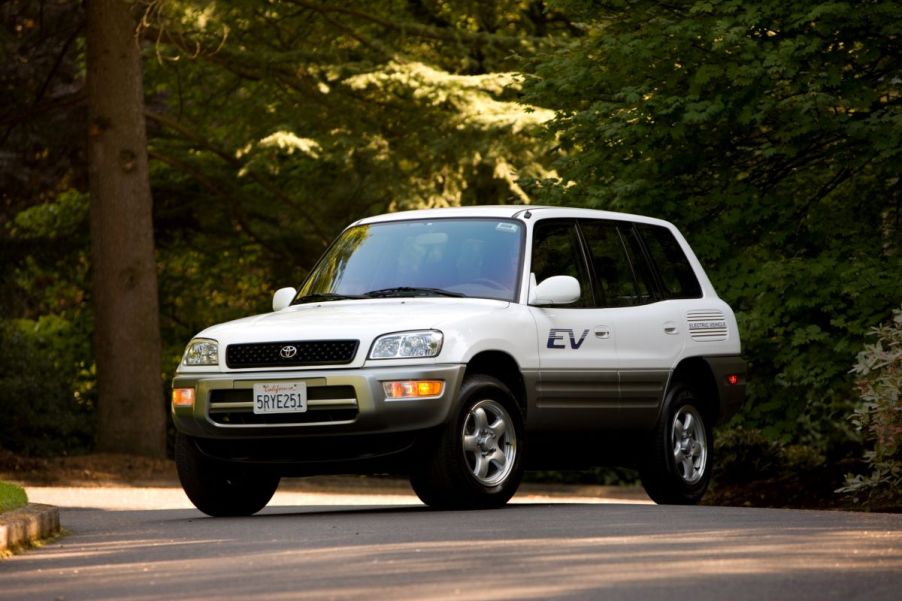
The Toyota RAV4 EV Is One of the Rarest SUVs You’ve Never Heard of Outside California
Although electric vehicles pre-date their traditional internal combustion engine counterparts, they have only gained popularity this century. The 1990s was the launch point of EV underpinnings seen today, with Chrysler, General Motors (GM), Ford, Honda, and Nissan working on all-electric models. But few remember the Toyota RAV4 EV as the first electric SUV—mainly because they were only sold on the West Coast.
Is the Toyota RAV4 EV the first EV?

No, the Toyota RAV4 EV came over 100 years after Gustave Trouve built his electric motor-powered tricycle in the 1880s. However, the RAV4 EV was Toyota’s first foray into vehicles powered by something other than fossil fuels.
In the late-1990s, the Japanese automotive giant wanted to test the waters with electric cars following the unveiling of the GM EV1, Chrysler TEVan, and other now-obscure examples. Partnering with battery maker Panasonic, Toyota designed a practical and environmentally-friendly alternative to traditional gas-powered SUVs. The RAV4 EV had a unique design that set it apart from other RAV4 models, with aerodynamic enhancements and unique exterior styling.
When it debuted in 1997, the public couldn’t buy it, though. It was a lease-only vehicle available to primarily California-based institutions. Internet titan Google, the City of Los Angeles, and even some U.S. Postal Service offices took them as runabout fleet vehicles. As Toyota executives received rave reviews of their experiment, they decided to scale up production.
The RAV4 EV went on sale to the public in 2002, but by 2003, Toyota wasn’t happy with the lack of excitement. And the company wanted to sell a lot of them. It was eligible for California’s Zero Emission Vehicle (ZEV) program. State legislation required automakers to produce a certain number of zero-emission vehicles, and the RAV4 EV helped Toyota meet its ZEV mandate.
One reason buyers may not have wanted a brand-new RAV4 EV was that gas was just $1.36 per gallon in 2002, USA Today reports. But another reason could be that Toyota’s all-electric SUV had a luxury car price tag. Autoblog said a RAV4 EV cost $42,000—in 2002. Unfortunately, after just 1,484 were produced—just 328 sold to private individuals—the RAV4 EV was discontinued in 2003.
What powered the Toyota RAV4 EV?

The Toyota RAV4 EV was powered by a 27-kWh nickel-metal hydride battery pack and had a range of roughly 80 miles on a single charge. It was equipped with a 50-kW electric motor, which allowed it to reach a blistering top speed of 78 mph. The Drive claims the motor provided 67 horsepower and 120 pounds-feet of torque, but it weighed just shy of 3,500 pounds. While that’s fairly light compared to the midsize SUVs of today, it was 550 pounds heavier than the internal combustion RAV4.
The front-wheel drive SUV received its propulsion through an inline differential. Yet, the drivetrain didn’t employ a standard transmission. Forward and reverse drives were managed by the direction of the three-phase AC motor.
While modern EVs have astonishing acceleration, the Toyota RAV4 EV did not. In pursuit of the 78-mph top speed, it took at least 18 seconds to hit 60 mph. In comparison, that’s more than twice the time it takes a Rimac Nevera to do 167 mph in the standing quarter-mile. But the RAV4 EV, with its aerodynamically-optimized body, did have contemporary touches.
By the time the EV SUV went on sale, it could be optioned with an inductive charging system based on the Magne-Charge system GM developed for the EV1 and the equally-mysterious Chevrolet S-10 Electric. Effectively, it was a turn-of-the-century household fast charger. It could pump enough juice into the battery to recharge in about six hours.
But that’s not all. The Toyota RAV4 EV had regenerative braking to extend the range. Not only did that power the motor, but also the heated front seats fitted as standard.
Was there a second generation?
A decade after the EV’s demise, Toyota decided to give the RAV4 EV another go. This time they would produce their second-generation electric SUV with one of the most popular automakers today: Tesla.
Toyota said the new 2012 RAV4 EV had an improved range. Up to 113 miles was possible, and cooperative regenerative braking increased driving range by 20%. A bigger 41.8-kWh lithium-ion battery was installed, which was the first liquid-cooled unit, a first for Toyota and Tesla. Another thermal management system included a smartphone-controlled climate system to pre-cool or pre-heat the vehicle before driving while it was plugged in, which conserved battery charge and range.
A 115-kW motor provided 154 horsepower, which made the electric SUV much quicker. Normally, the second-generation Toyota RAV4 EV could hit 60 mph in 8.6 seconds on the way to a top speed of 85 mph. In “Sport” mode, however, it had a seven-second 0-60 mph time and a 100-mph top speed. They even lowered the RAV4 EV’s drag coefficient to 0.30 CD, compared to the gas-powered RAV4’s 0.35 Cd.
Regrettably, the California-only vehicle had a short-lived production run. Just 2,600 units were sold to the public, and in 2014, citing limited demand and high production costs, Toyota announced the RAV4 EV’s discontinuation. Overall, the Toyota RAV4 EV had a tumultuous history, with production and availability limited by various factors. While it may not be well-known or widely available, it remains a fascinating and innovative vehicle that played an essential role in paving the way for today’s electric SUVs.


